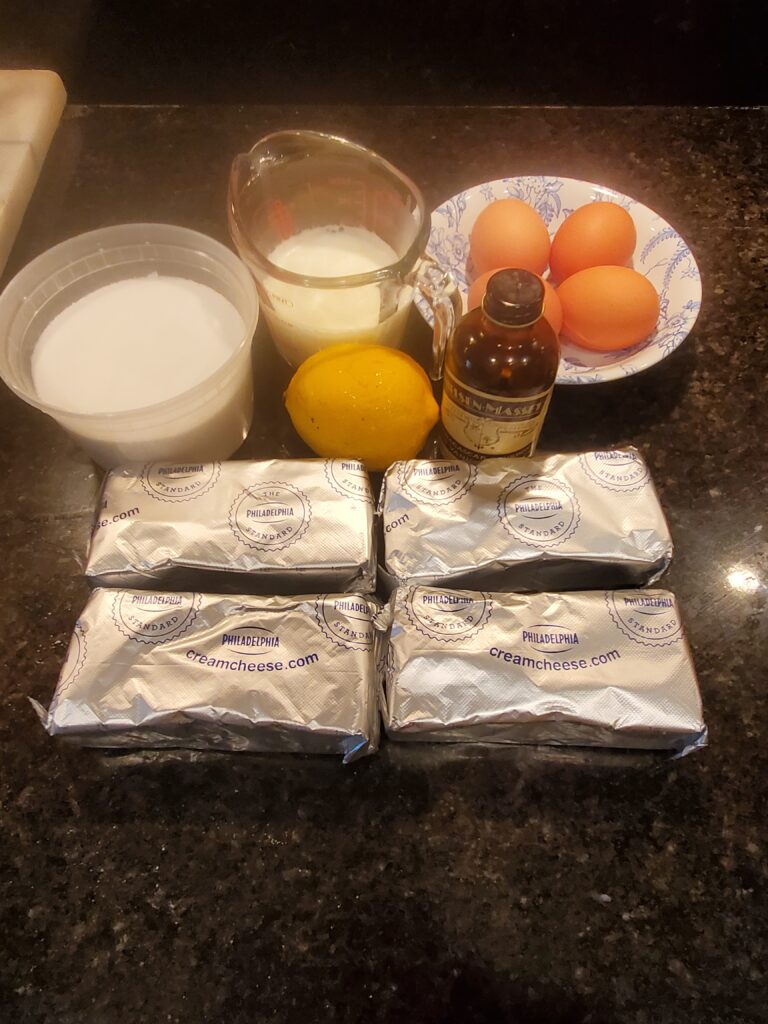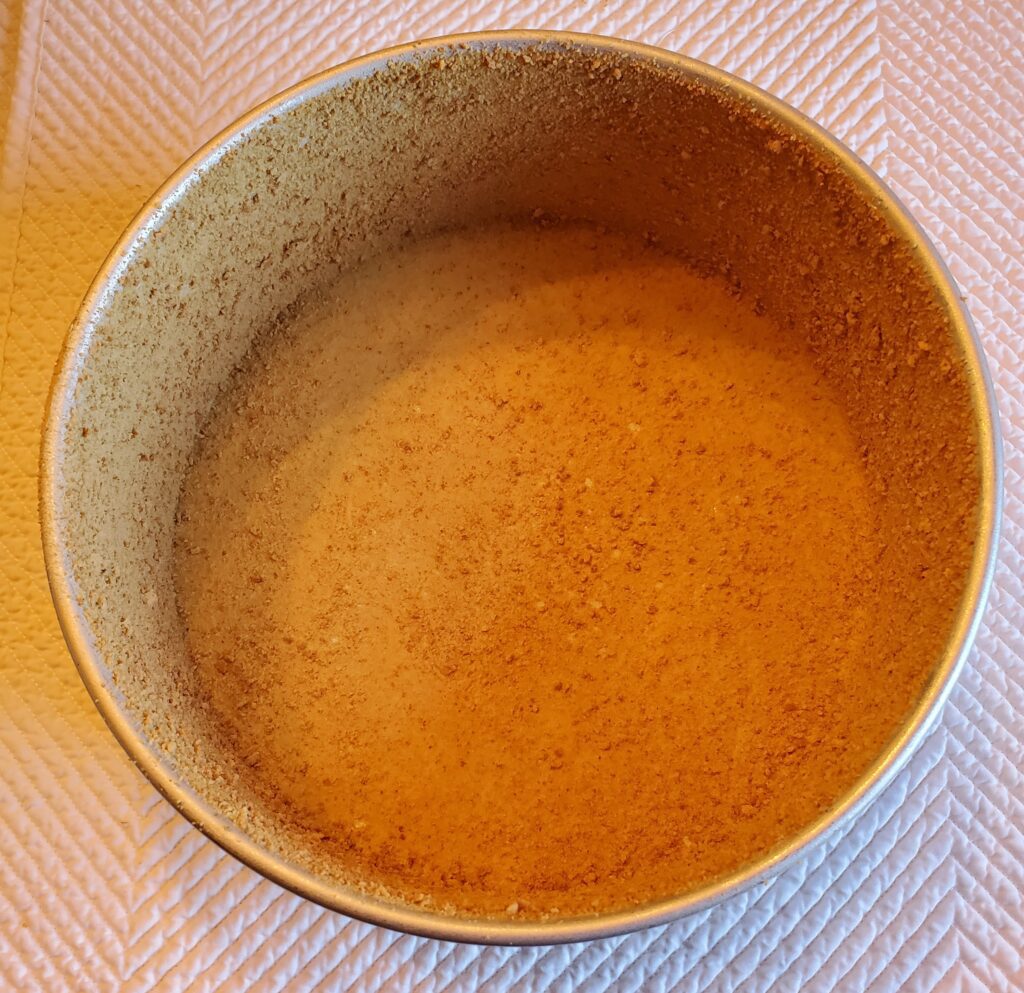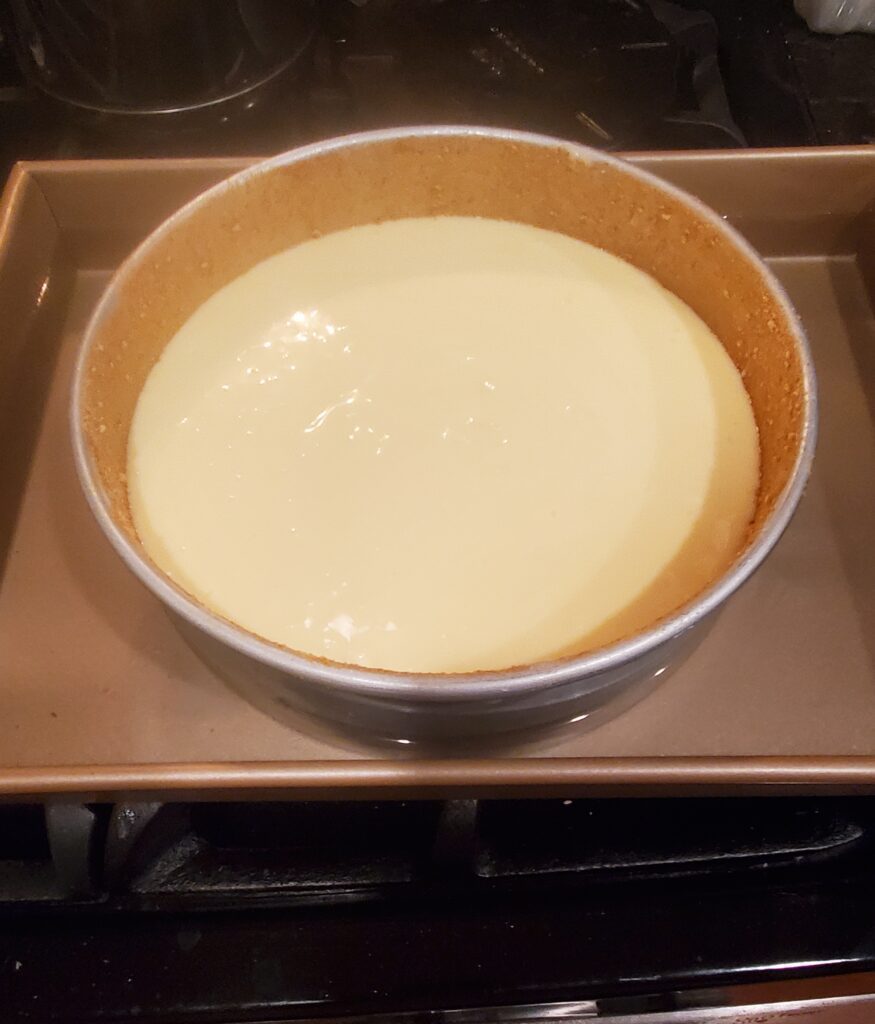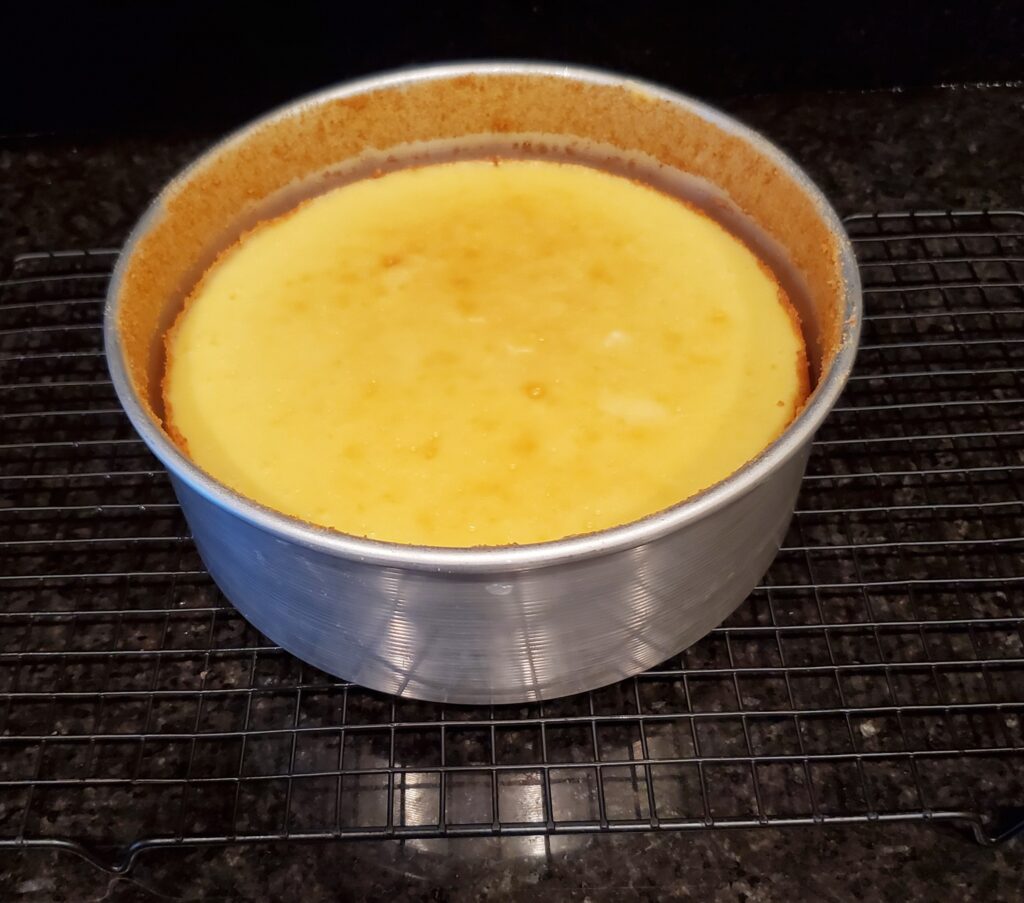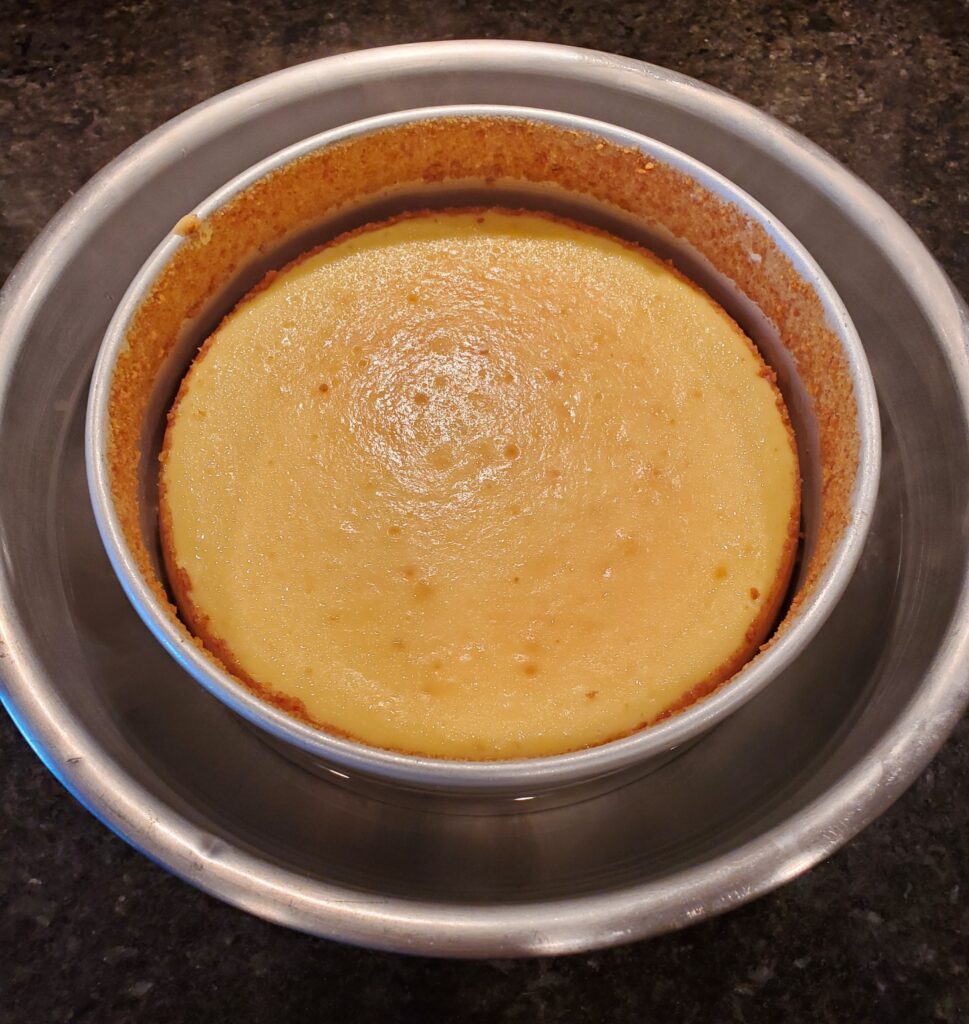Cheesecake
When I opened my Martha’s Vineyard baking business in 1982, the first restaurant client requested, among other desserts, a cheesecake. I tested a few recipes to no great enthusiasm, until I came upon one in Maida Heatter’s Book of Great Desserts, which itself was adapted from a Craig Claiborne recipe published in the New York Times.
Elements of both recipes were used to create my version of what I think is the ultimate Cheesecake. It is the essence of what cheesecake should be – creamy, smooth, with a hint of vanilla and lemon. This became part of the dessert offerings for other wholesale clients as well as customers of Seven Layers, my retail shop opened in 1986.
The Friday Baking Project had to include a cheesecake and I knew to look no further than my own Seven Layers recipe notebook. There it was, clearly written in batches calling for 12, 18, and 30 pounds of cream cheese. I remembered the 8-inch recipe called for 2 pounds of cream cheese so with simple calculations for the other ingredients I had the original 1982 recipe.

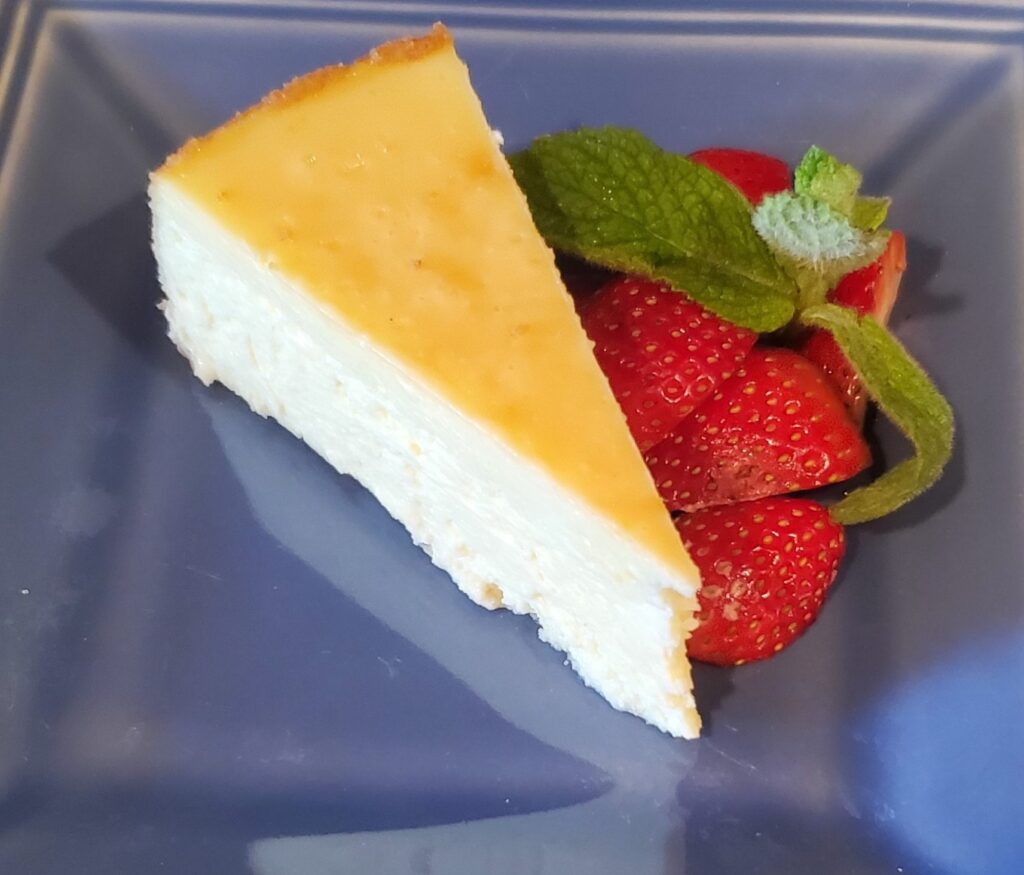
Steps one and two in that Seven Layers recipe highlighted the initial keys to cheesecake success; soft cream cheese and as little mixing as possible. Unlike creaming butter and sugar for cakes, when the goal is to beat air into the mixture, here the goal is to mix only enough to create a smooth, homogenous batter.
The final key to this cheesecake is baking it in a water bath, like a custard, which allows for slow, even baking resulting in its delightful creaminess.
The cake looked just as I remembered when removed from the pan and placed in the refrigerator to set overnight. As luck would have it the next day an invitation came to a backyard “bring a dish” dinner, so I had a built-in audience for the big taste test. The smiles on everyone’s face, and the “oh my, this is so good, maybe the best cheesecake ever,” statements reminded me exactly of why I love doing this.
This is a very straightforward recipe in terms of procedure and tools. The only special piece of equipment needed is a single piece 8-inch by 3-inch cake pan. The Fat Daddio company makes good quality ones and are available at Amazon. A springform will not work as water from the water bath will seep into the pan.
To make a gluten-free cheesecake, use any finely ground nut in place of the graham cracker crumbs.
Cheesecake
| Yield: 1 8″ cake | # of Servings: 12 to 14 |
Ingredients:
¼ cup (1.25 oz / 35 g) graham cracker crumbs (2 ½ graham crackers crushed)
2 lb. cream cheese (907g) (Philadelphia brand preferred), softened 1 ½ cup (11 oz / 311 g) sugar
4 large eggs, room temperature 1 tsp vanilla extract
½ cup heavy cream Grated rind from 1 lemon
Raspberry Sauce, optional
Tools and equipment needed:
- 8″ by 3″ cake pan.
- 8″ parchment paper circle.
- Large rectangular baker, roasting pan, or 10″ cake pan (Must be large enough for the cheesecake pan to sit in, with at least 1″ around all the edges, and not deeper than the cheesecake pan).
- Hand held or free-standing mixer with paddle attachment.
- Rubber spatula, dry and liquid measuring cups, tablespoon measuring set.
Pre-recipe preparations:
- Butter the cake pan, place the parchment circle in the bottom and butter the parchment.
- Place graham cracker crumbs into cake pan and swirl around so they entirely coat the pan. Set aside.
- Bring water to the boil in a water kettle, set aside on stove top.
- Preheat oven to 300 °F.
Directions:
- Put cream cheese in mixing bowl and beat for one minute on low speed.
- Add sugar and beat until smooth, scraping down sides of bowl. Only beat as long as necessary to combine ingredients. Do not overbeat.
- Break eggs into a liquid measuring cup or small bowl, add vanilla extract, and beat.
- Slowly add eggs to cream cheese mixture, beating just well enough each time for a homogenous batter. The mixture should be smooth after the eggs are added.
- Using a rubber spatula, stir in the heavy cream and lemon rind by hand. The batter should be the consistency of a smooth custard.
- Pour batter into pan.
- Place in larger pan and put in oven.
- Pour the hot water in larger pan until it is about 1 ½” deep.
- Bake for 2 hours.
- Turn off oven and let sit for 1 additional hour.
- Carefully take cheesecake pan out of water bath place on cooling rack, let thoroughly cool.
- Wrap top with plastic (careful not to touch cheesecake) and refrigerate for several hours, or overnight, until cold.
- To remove cheesecake from pan – heat water to almost boiling and pour into large mixing bowl until about â…“ full. The hot water will need to come ½ up the sides of the cheesecake pan.
- Place cheesecake pan in hot water for 30 seconds. Remove pan from water, dry the bottom on a dry dish towel. Place plate on top of cheesecake pan and invert onto plate. Immediately place a cake plate on the bottom of the cheesecake and flip so the cake is right side up.
- Serve plain, with fresh berries or raspberry sauce.
Baking tips:
- Importance of room temperature cream cheese: Unlike cake batters where butter and sugar are creamed together to beat air into the batter, in this recipe the cream cheese and other ingredients are beaten together just enough to combine for a smooth batter. This isn’t possible with cold cream cheese.
- To bring cream cheese to room temperature: take cream cheese out of refrigerator for approximately 3 hours. The cream cheese should be soft to the touch. It can be taken out of the foil wrappers, placed on a plate and microwaved for 15 to 20 seconds. It should register approximately 72 °F on an instant read thermometer.
- The cake plate that the cheesecake is turned out onto should have a flat surface diameter of at least 8″. Two cardboard cake circles may also be used for removing the cake from the pan.
- The best way to cut a cheesecake is by running the knife under hot water, and wiping clean with a paper towel after each slice.
